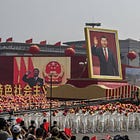The End of the Chinese Dream
While China is often now compared to Japan three decades ago, its outlook is actually much bleaker. Trump's tariffs make that much, much worse.
Don’t miss our Deep Dive “The Illusion of Chinese Strength: Power, Paranoia, and the Temptation of War”. It’s one of the most important things we’ve ever published.
by Yi Fuxian
April 14, 2025
On January 1, Chinese President Xi Jinping published an article reaffirming his longstanding belief that the East is rising, while the West is declining. But in his farewell address just weeks later, outgoing US President Joe Biden made a point of saying that the US has “pulled ahead in [its] competition with China.” Biden saw what Xi would prefer to ignore: the demographic foundation of China’s economy is crumbling.
This problem is not new. Back in 2016, I told the New York Times that China’s aging population and shrinking labor force would prevent its economy from overtaking America’s — a conclusion I had arrived at in the 2007 and 2013 editions of my book Big Country with an Empty Nest.
Chinese authorities were not happy. I immediately went from being a state guest to a name on the government’s blacklist. Then, in 2019, I angered the authorities again by publishing a commentary bearing the headline: “Worse than Japan: how China’s looming demographic crisis will doom its economic dream.”
According to the dominant narrative at the time, the “Chinese century” was “well under way” (as The Economist put it). Nonetheless, my findings met with a receptive audience. In the introduction to a November 2020 Brookings Institution book on “the future of US policy toward China,” my commentary was the sole reference listed. (The author, Jeffrey Bader, had been one of the principal architects of the Obama administration’s “pivot to Asia.”) Since then, the dominant narrative has shifted, with many more analysts warning of China’s “Japanification.”
Japan’s experience has confirmed that demographics matter for economic growth, and this will remain the case regardless of whether one looks at Germany, France, China, or any other country. Owing to a rapidly growing workforce and a young population, Japan’s GDP grew from a mere 9% of US GDP in 1960 to 73% in 1995, and its per capita GDP grew from 17% of America’s to 154% in the same period. By 1990, Americans had come to regard Japan as their chief rival, with polls showing that three times more Americans feared the economic threat posed by Japan than the military one posed by the Soviet Union.
Yet Japan’s GDP growth rate has been lower than America’s since 1992. That is when its ratio of working-age people (15-64 years old) to people over 65 began to fall below that of the United States. By then, its median and mean ages were five and three years above America’s, respectively, and its proportion of elderly people had already exceeded America’s the prior year. Its prime-age labor force (aged 15-59) has been declining since 1995, whereas America’s will continue to grow throughout this century. As of 2024, Japan’s GDP had fallen to just 14.5% that of the US, and its per capita GDP had fallen to 38% of the US level.
South Korea followed a similar trajectory. In 2019, its median and mean ages were five and three years above the US, respectively; and, in 2021, the share of those over 65 exceeded that of the US. Its labor-to-elderly ratio will fall below America’s next year, and its GDP growth rate has been lower than America’s since 2021.
More Japanese Than Japan
China’s trajectory has been similar to Japan’s, except that its fertility rate is even lower. In 2000, 2010, and 2022, Japan’s fertility rate (children per woman) was 1.36, 1.39, and 1.26, respectively, whereas China’s was only 1.22, 1.18, and 1.05. China is now struggling to stabilize its fertility rate at a meager 0.8 — less than half the “replacement rate” (2.1). Its prime-age labor force has been shrinking since 2012, not coincidentally when its three-decade run of double-digit GDP growth ended.





